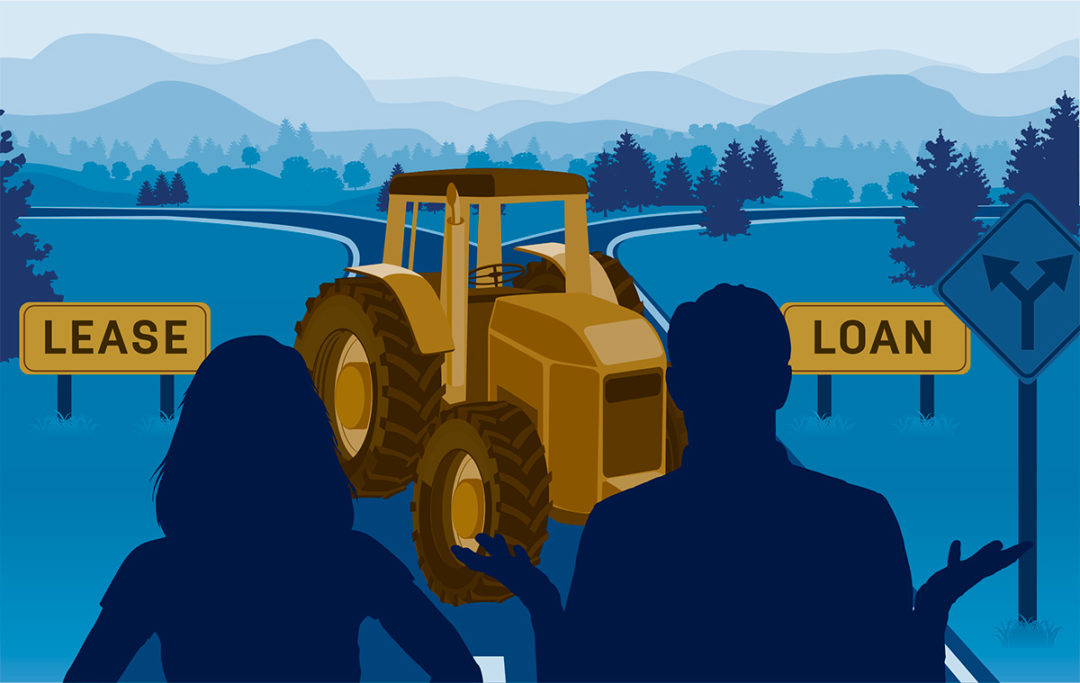“If you don’t know where you are going, you’ll end up someplace else.
—Yogi Berra
It’s one of my favorite Yogi-isms. Paraphrased, it means you’ve got to know your objective before you flip the switch to full steam ahead. That’s certainly the case with ag equipment financing. Farmers have an abundance of options, and it quickly becomes overwhelming to figure out the best way to finance equipment needs. The key to making an informed decision is a clear sense of your goals and a good handle on your current situation. That’ll help any ag producer determine whether a term loan or a lease is the right call for their next piece of equipment.
The terms of term loans
Loans are the traditional approach to equipment financing. Individual loans for each purchase are available, but it’s important to note that any fixture within ag real estate – whether it’s a tractor, irrigation systems, corrals or storage facilities – can often be financed within the real estate term loan. It is imperative to consider if this benefits the farmer in the long run. Do you want to finance an asset like a pivot irrigation system over 30 years? Maybe, but maybe not.
Consider if you will need to replace the asset before the real estate term loan reaches maturity. In this case, you may be better off separating machinery and equipment into a specific term loan to match the useful life or the depreciation of the asset. From a cash flow perspective, another option would be to stretch out the payments over the long lifetime of a real estate loan to reduce the immediate cash flow impact. The combinations and possibilities are endless.
Most term loans will fund new equipment on a five-year or seven-year repayment schedule. But even these term loans have options; a variable interest rate, a fixed rate or a hybrid rate are all available. Be aware that there may be penalties if you want or need to pay the loan off early – a particular concern with fixed-rate term loans.
A better option may be a term loan that provides a line of credit within a specified “acquisition period.” This gives a borrower as long as 12 months to use this line of credit to acquire multiple pieces of equipment. Ag producers can then convert those borrowed funds into the term note. Some banks and finance companies will even facilitate the purchase of used equipment, or a combination of both used and new equipment, in this way. The right ag banking partner will provide you with the financing and flexibility to help you meet your equipment needs.
Know your leasing options
Leasing is the alternative. Leases are beneficial due to the initial flexibility and minimal risk. Most lease agreements offer 100% financing and could potentially offer more competitive borrowing costs and fewer fees. However, once they are in place it can be extremely difficult to change the terms or pay them off early without steep prepayment penalties or change-in-terms costs. Lease agreements often require an initial upfront lease payment. If you are on a five-year lease with annual payments, it may not feel much like 100% financing to you as the lease holder.
That said, leasing can help producers keep pace with improving technologies. The rapid pace of innovation can make new equipment obsolete in as little as two years. Lease holders can return outdated equipment in favor of the latest and greatest, while purchasers must make do with the equipment they’ve financed.
Keep in mind: Some lease agreements are closer to a rental. Known as an operating lease, this type of lease requires that an asset be returned at the end of the contract. The cost to lease holders can be more flexible and user-friendly compared to traditional finance leases. In some cases, operating leases include a protected residual or “early buyout option” (EBO) structure where the producer can buy out the lease early. But if you do not exercise the EBO on time, the repercussions can be costly if you still want to own the equipment.
This contrasts with finance leases that may only have a nominal $1 buyout at the end of the lease maturity to own the borrowed equipment – a significantly more affordable option than the “fair market value” you’ll pay if you miss the EBO deadline as part of an operating lease.
Finally, the key to evaluating any lease agreement is understanding the organization behind the lease and determining their benefit. Some banks own equipment finance subsidiary companies and may offer leasing through them. Most traditional equipment finance companies and dealer finance companies provide leasing options. Knowing how the companies benefit will help to determine if the terms benefit you.
To lease or not to lease?
With so many equipment financing choices available, it’s always best to define your objectives and discuss any plans with your accountant or other tax consultant, as IRS rules change periodically. Ag banking partners can also guide farmers to finding the best-fit options for achieving and exceeding their business goals. As Yogi once said, “When you come to a fork in the road, take it.” But first, make sure you understand where it is likely to take you.





.jpg?height=auto&t=1713304395&width=285)


